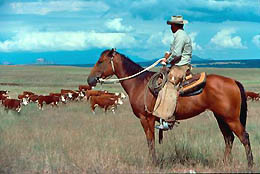Originally appearred in the Missoulian.
Until Cliven Bundy shot himself in the foot with his racist diatribe, he was helping to rekindle the Sagebrush Rebellion of the 1970s. Mr. Bundy grazed his cattle on Bureau of Land Management land in Nevada and refused to pay over $1 million in grazing fees and fines because he claims the federal government has no right to the land.
Jumping on the Bundy bandwagon, many state legislators are trying to build support for the passage of laws similar to Utah’s Transfer of Public Lands Act. The law, signed by Governor Gary Herbert in 2012, calls on the federal government to turn over thousands of acres of commodity producing lands to the state.
Lawmakers from eight western states joined forces on April 18 in Salt Lake at a summit to declare “enough is enough” when it comes to the mismanagement of federal lands in their states. One of the summit organizers, Montana Sen. Jennifer Fielder, said, “There is a distinct difference in the way federal agencies are managing the federal lands today. They used to do a good job, but they are hamstrung now with conflicting policies, politicized science, and an extreme financial crisis at the national level. It makes it impossible for these federal agencies to manage the lands responsibly anymore.”
Almost no one with an interest in federal land management can disagree with Fielder’s conclusion—even the land managers themselves. As Jack Ward Thomas, former chief of the Forest Service, put it, federal land management is tied in a “Gordian knot” of laws and litigation.
When the first Sagebrush Rebels made the same point, most thought the movement was about privatizing the federal estate. But neither ranchers nor environmentalists want the government out of land management. They just want the locus of management to be where they think they can more easily get what they want. Both sides should be careful what they ask for.
Today’s Sagebrush Rebels want federal lands transferred to the states. But if they succeed, grazing fees would likely increase. In Montana, BLM grazing fees are $1.35 per AUM (animal unit month—the amount of land necessary to support a cow-calf pair for one month), while the state land fees are between $6.12 and $80. Moreover, if managed under state trust land requirements, the land would have to turn a profit. In fiscal year 2004, the year for which we have the best estimates, the BLM lost over $55 million dollars on its grazing programs, and the Forest Service lost another $60 million. Admittedly, this is as much due to high management costs as it is to modest revenues, so turning a profit would require adjustments on both sides of the ledger. Are ranchers ready to have less taxpayer money spent on their grazing lands and to pay more for their permits?
Environmentalists, on the other hand, want more control in Washington D.C., where urban constituencies can have a say in land management decisions. When President Clinton occupied the White House, environmentalists carried signs calling for “No Moo in ‘92″ and “Cattle Free in ’93.” Their political pressure helped reduced grazing on federal lands from 8.3 million AUMs in 1991 and to 7.9 million in 2013. At the same time, however, grazing fees plummeted from about $2.00 per AUM to $1.35, the minimum that can be charged, where they remain today.
But “no moo” may mean fewer tweets, clucks, and bugles from wildlife. As private ranchers demonstrate, good land management can control noxious weeds, improve water quality, sequester more carbon, and generate more wildlife habitat. Ecologist and rangeland specialist Dan Daggett has documented hundreds of cases where cattle grazing has improved the ecosystem.
At a time when federal deficits are running at their highest levels ever and when guns are literally drawn over public land management, perhaps it is time for a real land management rebellion. It is time to consider privatization rather than more politicization of federal lands. We could start by selling off millions of acres of grazing lands. Private ranchers have proven that they are good stewards of the land they own, both in terms of livestock production and ecosystem services. If environmental groups want to have authority in land management, they should also accept responsibility by buying lands, as groups such as the Grand Canyon Trust and the American Prairie Reserve already do. Perhaps a little experimentation of this sort would provide further evidence that fiscal responsibility and environmental responsibility go hand-in-hand.



